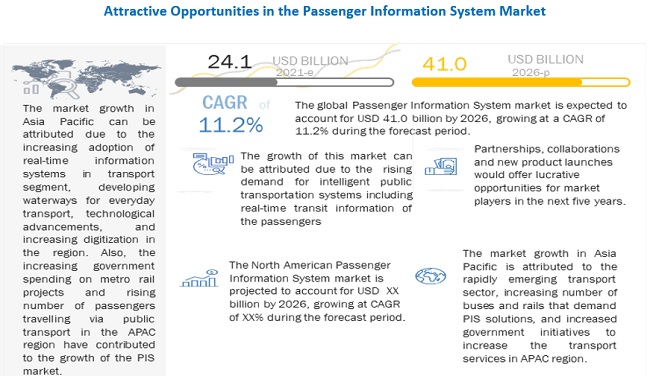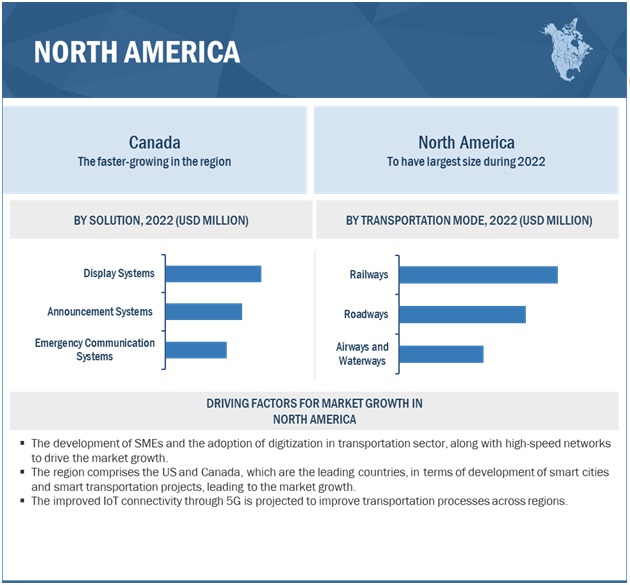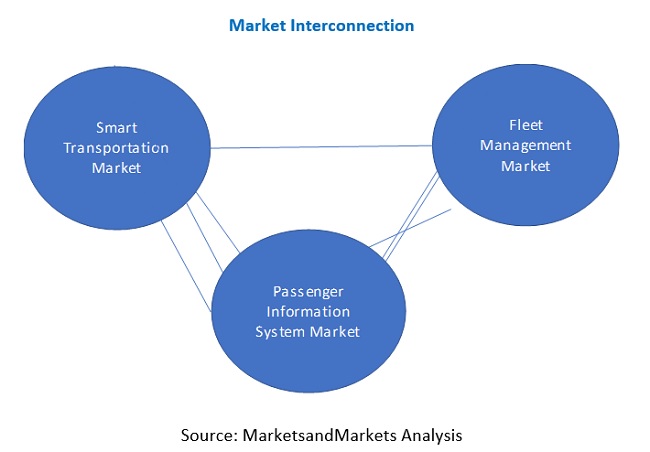< Key Hightlight >
The global Passenger Information System market size is expected to grow from USD 24.1 billion in 2021 to USD 41.0 billion in 2026, at a Compound Annual Growth Rate (CAGR) of 11.2% during the forecast period. The major factors driving the growth of the Passenger Information System (PIS) market include the rise in demand for intelligent public transportation systems, including real-time transit information of passengers, extensive usage of smartphones and other handheld devices with increased connectivity, increase in the usage of advertising and information systems, advancements in the technological landscape to enhance the passenger experience, and a surge in urban population and traffic in public transportation systems.

To know about the assumptions considered for the study, Request for Free Sample Report
Impact of Covid-19 on Passenger Information System market
The rise in the number of COVID-19 cases has caused a major blow to the transportation industry, which, in turn, has affected the PIS market growth. With most of the governments enforcing isolation practices, there is a substantial decline in the transportation industry across all the modes of transportation. The ongoing projects related to electric vehicles have been stalled now, and most manufacturers of electric vehicles, such as Tesla, have shifted their focus to the production of ventilators, which is witnessing significant demand. The application of IoT is still opening new revenue streams by facilitating real-time tracking of vehicles and providing monitoring feeds of passengers. The monitoring feeds of passengers help in checking passenger travel histories to identify if the passenger needs to be quarantined. Companies are using drones as another mode of transportation to ensure essential supplies and food deliveries. The Shenzhen-based startup, Pudu Technology, aimed to reduce the cross-infection by implementing home delivery of drugs and meals via drones and robots. Railways, as one of the major transportation modes for passengers, would be able to provide safe and independent compartments in which a small number of passengers would be able to travel and apply social distance measures. By tracking passengers in the different compartments, rails would be able to provide data to detect the passengers who could have been exposed to the virus during their journey.
Market Dynamics
Driver: Rise in demand for intelligent public transportation systems, including real-time transit information of passengers
The growing demand for intelligent public transportation systems that provides real-time transit information for passengers is projected to drive the growth of the PIS market. As the demand for real-time information of passengers is increasing, transport service providers and transit agencies are deploying PIS solutions and services to enhance the travel experience of passengers. Currently, the public transportation industry needs to increase overall operational efficiency and passenger retention. This can be attained by increasing the level of customer or passenger experience. In order to increase passenger satisfaction, transport service providers are upgrading their information systems by offering new features, such as real-time data availability and in-transit network connectivity. The upgraded PIS provides passengers with real-time customized travel information.
Restraint: High costs involved in implementing and maintaining the passenger information systems
The overall cost of a PIS system includes the implementation and maintenance costs that can inhibit the PIS market growth. The implementation costs primarily consist of the cost for designing the system, purchasing and installing the equipment needed for the system to work (including conduit), and monitoring the quality of the system before it is released to the public. The maintenance costs comprise the entire cost of all inputs required to operate and maintain the real-time PIS solutions and services. It also includes operating costs that consist of electricity costs required to power the systems, cost of data transfer between units of the system, and the parts and equipment utilized by maintenance staff in conducting their work. The maintenance of the PIS system requires special attention as the information about the passenger and public transport keeps on changing. PIS systems also provide information about the inclusion of new Passenger Transport (PT) operators in the Integrated Passenger Information (IPI) system, vehicle fleet changes as per requirements, and vehicle equipment breakdowns.
Opportunity: Adoption of IoT, 5G, and automation technologies to enhance technological optimization
The evolution of IoT has enabled the exchange of information between different electronic devices without the need for direct human interaction. The convergence of IoT platforms with PIS is projected to help drive the growth of the market. According to Ericsson’s Mobility Report and IoT Forecast, there will be nearly 18 billion IoT devices offered by 2022. IoT is a combination of storing, processing, and computing sensor data using data analytics to achieve and assist the management of traffic systems effectively. IoT-based Intelligent Transportation Systems (ITS) help automate railways, roadways, airways, and marine lines, enhancing the travel experiences of passengers. Smart devices integrated for improved connectivity, automation, and control are projected to become more self-governing and intelligent in terms of sharing data with transportation management control centers and the cloud.
Challenge: Complexities in the integration over the legacy infrastructure and communication networks
Legacy systems are outdated computer software and hardware that remain in use even after the installation of modern technologies. Legacy systems are crucial for organizations as they support some key functionalities of the business. Organizations require to upgrade their legacy systems as it becomes difficult to continue with systems whose services are discontinued from vendors. Many of the legacy systems do not have the configuration required to connect with smart devices and enhanced communication networks. The PIS market vendors face challenges in integrating these legacy systems with various components present in the smart public transportation ecosystem. The smart public transportation ecosystem integrates multiple technology elements, such as software, hardware, and network elements, and involves multiple vendors. The integration of smart technology elements with legacy transportation systems is highly complex due to the lack of an open interface and protocol issues. These integration issues would then lead to communication gaps between traditional systems and technologically advanced systems. In addition, the upgradation of legacy systems requires high investments. These complexities are expected to restrict the PIS market growth in the coming years.
Display systems, by solutions segment to account for a larger market size during the forecast period
The display systems segment is projected to hold the largest market size during the forecast period. The display systems segment in the PIS market acts as a digital information system that displays real-time information for passengers. These systems are installed in the following station areas to display relevant information on metro/train times and metro/train destinations to passengers that include the station ticket halls, station platforms, station entrances, interchange corridors at interchange stations, and other modes of transport. The display system, with the help of several disruptive technologies, such as IoT, big data, cloud, AI, ML, and automation, helps the passenger to get real-time information to the passengers both in the station and On board.
Deployment and Integration, by service segment to grow at a higher CAGR during the forecast period
The deployment and integration services segment is projected to account for the largest market size during the forecast period. The deployment and integration services help in identifying the need for the adoption or upgradation to support the PIS solutions in the existing infrastructure to avoid restrictions of such solutions. These services help in the speed deployment of PIS solutions, save time and cost, enable efficient working, and minimize deployment-related disruption.
On board, by location segment to lead the market during the forecast period
The on board location is projected to dominate the global PIS location market in terms of market share. The exponential increase in smartphone usage and advancements in network infrastructure enables transport authorities to provide timely status and updates On board in a cost-effective way. These advancements are projected to drive the demand for PIS solutions for On board locations. In addition, the need to inform passengers about the next/previous stations or stops and provide advanced vehicle information, such as precise arrival and departure information, is projected to create opportunities On board PIS solutions in the market.
Roadways, by transportation mode segment to grow at a higher CAGR during the forecast period
The demand for accurate and timely delivery of passenger information continues to grow across all modes of transportation. The public transport industry is focusing on catering to the needs of passengers by offering accurate information before, during, and after the customer journey. Hence, transit agencies are implementing PIS solutions to better inform passengers about their journey details in real-time. The emerging technologies in the PIS market help improve the reliability of public transportation networks by providing visibility into information on arrivals/departures/routes for travelers to offer a hassle-free journey across different transportation modes. The roadways segment is projected to grow at the highest rate, as there are a large number of buses in the transportation sector and PIS solutions that are witnessing an increase in the adoption of buses for reliable and safe service offerings and enhancing the overall transit operations.

To know about the assumptions considered for the study, download the pdf brochure
North America to account for the largest market size during the forecast period
North America is projected to account for the largest market size among other regions in the PIS market, and the trend is projected to continue until 2026. The US and Canada are the leading countries in the region as they witness significant advancements in terms of the development of smart cities and transportation projects. These countries have sustainable and well-established economic growth, empowering them to increasingly invest in R&D activities, thereby contributing to the development of new technologies in the PIS market. North America is one of the most developed regions where the network infrastructure is in good condition. This has led to a rise in demand for PIS solutions and services in the market. Most of the transport sectors have implemented PIS solutions and services in the region on a large scale as the network connectivity is available in every corner. The advent of SMEs and the adoption of digitization in the transportation sector, along with high-speed networks, are projected to drive the market growth in North America. In addition, 5G continues to be the backbone for IoT connectivity due to its high speed and low latency. The improved IoT connectivity through 5G solutions is projected to improve transportation processes in the region, which leads to the market growth.
The growing ridership in public transport is also encouraging the demand for PIS solutions in North America. PIS enables passengers to get relevant information regarding the status of different modes of transportation, such as airplanes, trains, trams, and buses, in real-time. A sudden increase in the average number of vehicles has led to traffic congestions, which means the loss of several hours on roads or rails. Therefore, public transport services that provide real-time information to passengers using PIS solutions make it a better option for passengers. Some other factors that are encouraging the market growth in North America include increased government investments to offer more public transport services and the requirement of vehicle data in real-time from government agencies. The North American transport industry is well-developed, and transit operators are using PIS solutions for the betterment of service offerings to increase the market presence by improving the traveling experience of passengers.

Market Players
The report includes the study of key players offering Passenger Information System (PIS) market offerings. It profiles major vendors in the global Passenger Information System (PIS) market. The major vendors include include Advantech Co., Ltd. (Advantech), Alstom (Alstom), Wabtec Corporation (Wabtec), Cubic Corporation (Cubic), Cisco Systems, Inc. (Cisco), Siemens AG (Siemens), Hitachi, Ltd. (Hitachi), Huawei Technologies Co., Ltd. (Huawei), Thales Group (Thales), Teleste Corporation (Teleste), Televic Rail (Televic), Mitsubishi Electric Corporation (Mitsubishi Electric), ST Engineering (ST Engineering), DYSTEN Sp. z o.o. (DYSTEN), Lunetta (Lunetta), R2P GMBH (r2p), Sistemas, S.A. (Indra), ICON Multimedia S.L. (ICON Multimedia), passiotech.com (Passio Technologies), LANCom Systems GmbH (LANCom), Simpleway Europe a.s. (Simpleway), EKE-Electronics Ltd (EKE-Electronics), Medha Servo Drives Private Limited (Medha Servo Drives), Quester Tangent (Quester Tangent), and LOT Group (LOT Group). The study includes an in-depth competitive analysis of these key players in the Passenger Information System (PIS) market with their company profiles, recent developments, and key market strategies.
Scope of Report
Report Metric | Details |
Market size available for years | 2016–2026 |
Base year considered | 2020 |
Forecast period | 2021–2026 |
Forecast units | Value (USD Million) |
Segments covered | Component (Solutions And Services), Location, Transportation Mode, Functional Model, And Region. |
Regions covered | North America, Europe, APAC, Latin America, and MEA |
Companies covered | Advantech (Taiwan), Alstom (France), Wabtec (US), Cubic (US), Cisco (US), Siemens (Germany), Hitachi (Japan), Huawei (Japan), Thales (France), Teleste (Finland), Televic Rail (Belgium), Mitsubishi Electric (Japan), ST Engineering (Singapore), DYSTEN (Poland), Lunetta (India), r2p (Germany), Indra (Spain), ICON Multimedia (Spain), Passio Technologies (US), LANCom (Slovenia), Simpleway (Czech Republic), EKE-Electronics (Finland), Medha Servo Drives (India), Quester Tangent (Canada), and LOT Group (Ukraine). |
This research report categorizes the Passenger Information System (PIS) market to forecast revenues and analyze trends in each of the following submarkets:
Based on Component, the Passenger Information System (PIS) market has the following segments:
- Solutions
- Display Systems
- Announcement Systems
- Emergency Communication Systems
- Mobile Applications
- Infortainment Systems
- Others (Passenger Counting Systems and Video Monitoring Systems)
- Services
- Consulting
- Deployment and Integration
- Support and Maintenance
Based on Location, the Passenger Information System (PIS) market has the following segments:
Based on Transportation Mode, the Passenger Information System (PIS) market has the following segments:
- Railways
- Roadways
- Airways and Waterways
Based on Functional Model, the Passenger Information System (PIS) market has the following segments:
- Multimedia Display
- Audio Systems
- Computing Systems
- Networking and Communication Devices
- Video Surveillance
- Content Management System
- Other Functional Models
Based on regions, the Passenger Information Management (PIS) market has the following segments:
- North America
- Europe
- UK
- Germany
- France
- Rest of Europe
- APAC
- Latin America
- Brazil
- Mexico
- Rest of Latin America
- MEA
- UAE
- South Africa
- Rest of MEA
Recent Developments:
- In December 2020, Advantech and VinBus Ecology Transport Services Limited Liability Company (VinBus) signed a strategic cooperation contract on the development of the intelligent electric bus management system.
- In January 2021, Alstom has acquired Bombardier Transportation. As a part of the acquisition, Alstom would strengthen its leadership in the growing sustainable mobility market by reaching a critical size in all geographies and integrating further solutions and assets to better serve its customers worldwide.
- In June 2020, Wabtec launched an air-filtration innovation called BlueFilter to provide a clean and healthy environment for passengers on metro and trains. The TÜV-tested filter continuously provides fresh and clean air onboard metro and railcars by removing more than 90% of contaminants per air cycle. BlueFilter’s design removes contaminants that are 0.1 to 1,000 micrometers in size. These include allergens, bacteria, various dust, and viruses.
- In January 2021, Cubic launched Umo, a fully integrated suite of platforms for riders, transit agencies, and mobility service providers to complement its existing portfolio of transportation technology.
Key Benefits of Buying the Report
The report would provide the market leaders/new entrants in this market with information on the closest approximations of the revenue numbers for the overall Passenger Information System (PIS) market and its subsegments. It would help stakeholders understand the competitive landscape and gain more insights to better position their business and plan suitable go-to-market strategies. It also helps stakeholders understand the pulse of the market and provides them with information on key market drivers, restraints, challenges, and opportunities.




